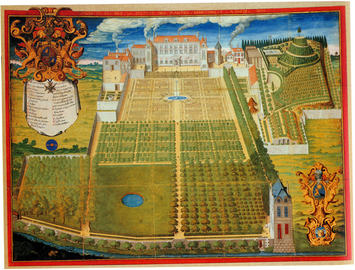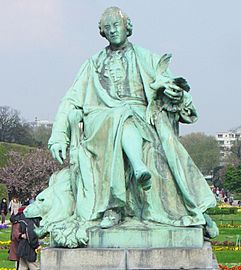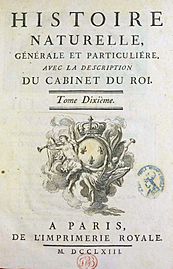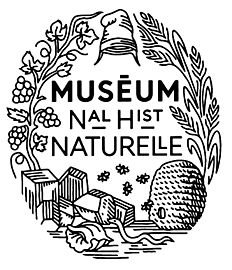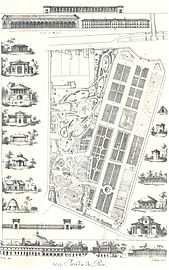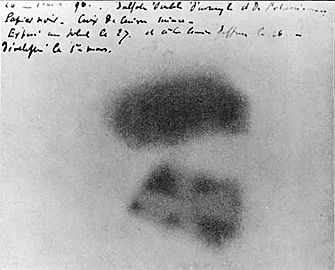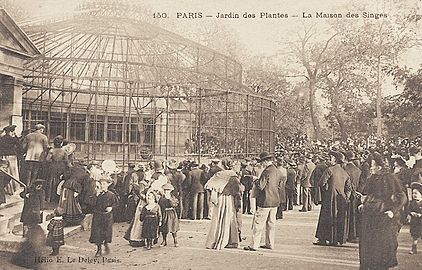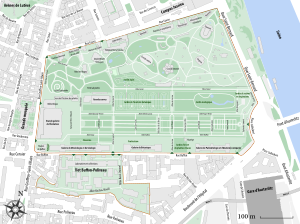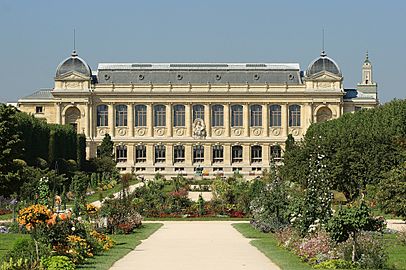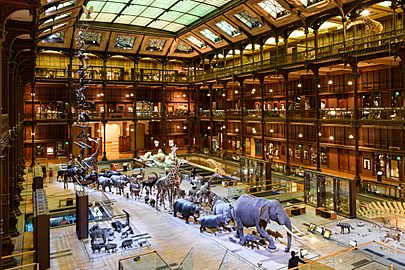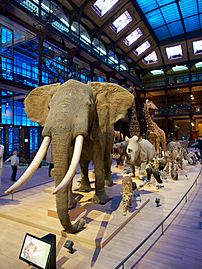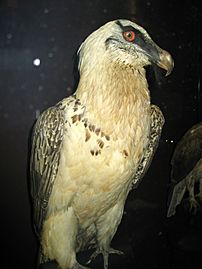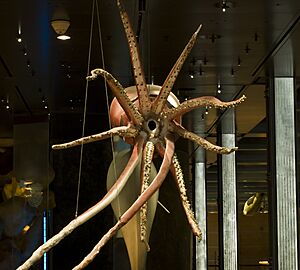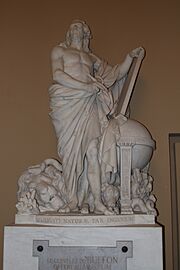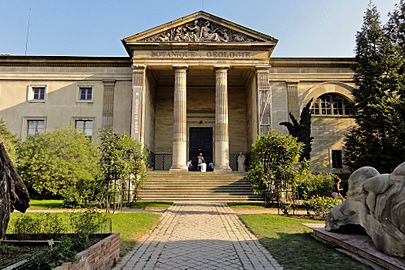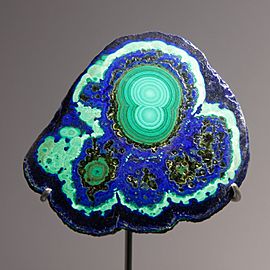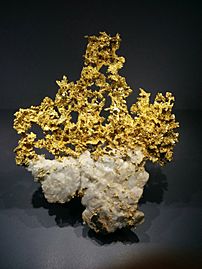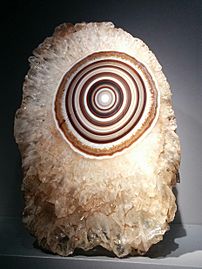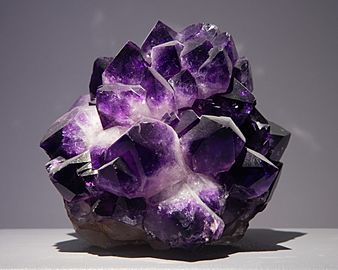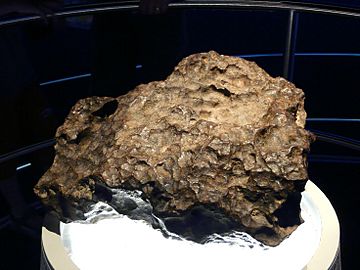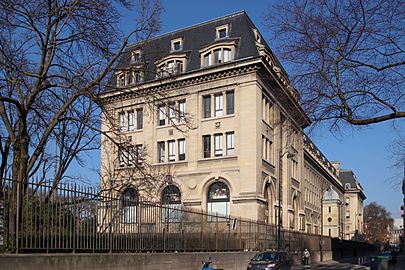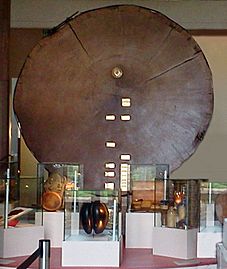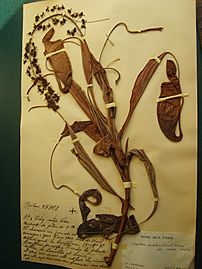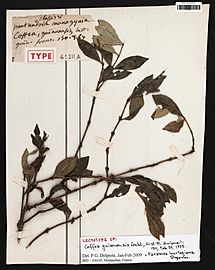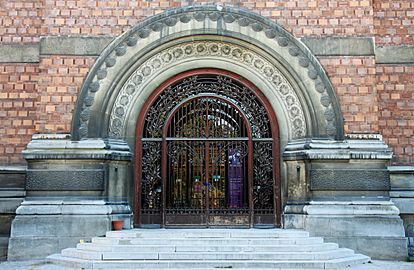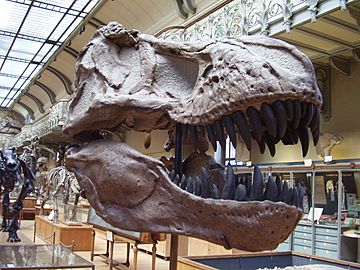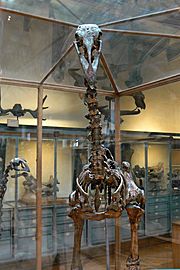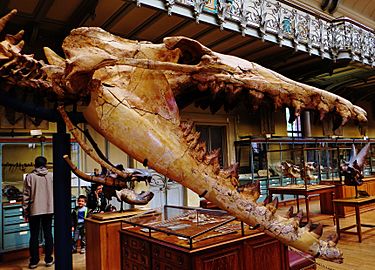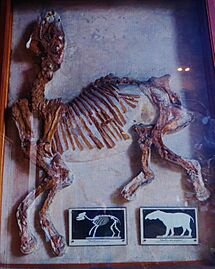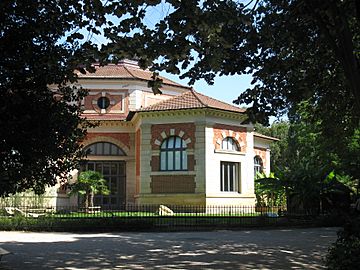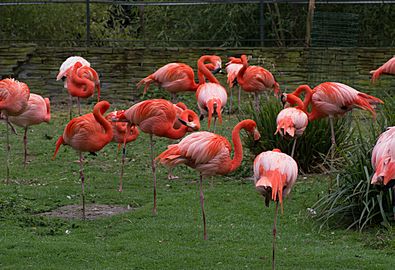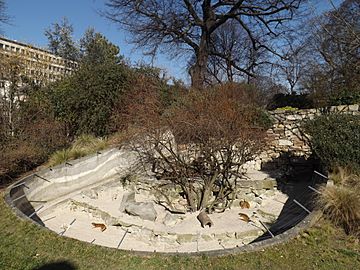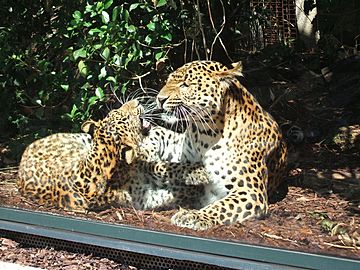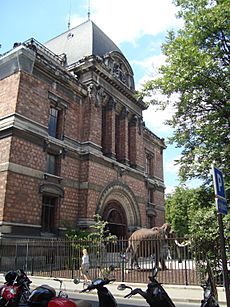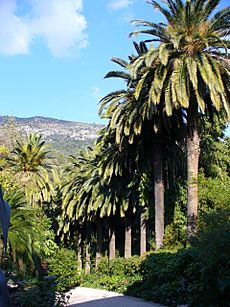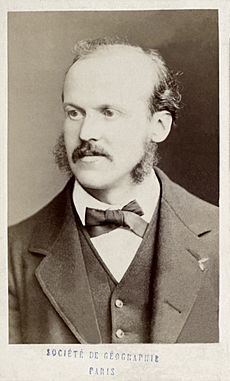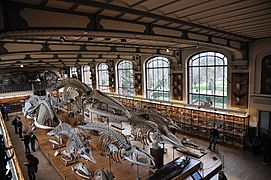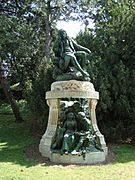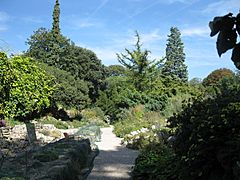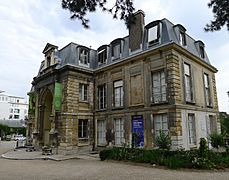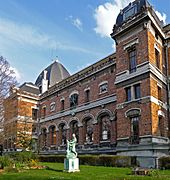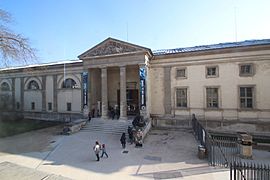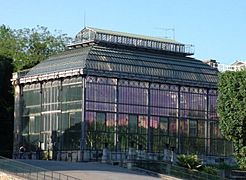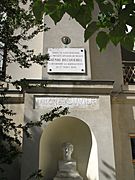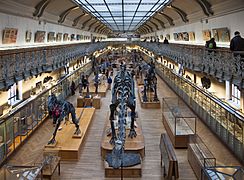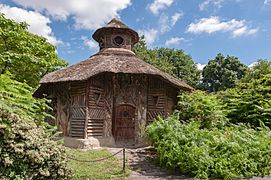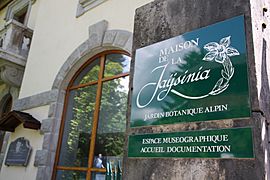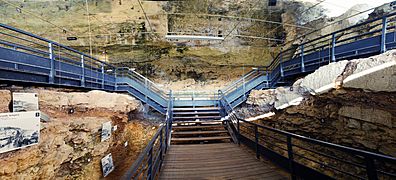National Museum of Natural History, France facts for kids
| Muséum national d'histoire naturelle | |
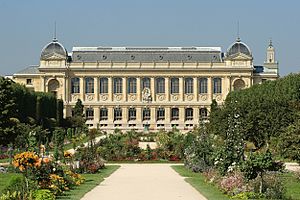
Grand Gallery of Evolution of the National Museum of Natural History
|
|
| Lua error in Module:Location_map at line 420: attempt to index field 'wikibase' (a nil value). | |
| Established | June 10, 1793 |
|---|---|
| Location | 57 Rue Cuvier, Paris, France |
| Type | Natural history museum, part of Sorbonne University |
| Collection size | 67 million specimens |
| Visitors | 3.8 million in 2023 |
| Public transit access | Jussieu Place Monge Austerlitz |
| Muséum national d'histoire naturelle network | |
|
|
The National Museum of Natural History (known as MNHN) is France's main museum for natural history. It's also a big part of Sorbonne University. The museum's main location is in Paris, France. You can find it inside the Jardin des Plantes, which is a large garden by the Seine River.
The museum officially started in 1793 during the French Revolution. But its story began much earlier, in 1635, as a royal garden for medicinal plants. Today, the museum has 14 different sites all over France. It has a large team of about 2,350 people, including 600 researchers.
Contents
History
How it Started: 17th–18th Century
-
Statue of Georges-Louis Leclerc, Comte de Buffon in the formal garden
The museum was officially created on June 10, 1793. This happened during the French Revolution, at the same time the Louvre Museum was also started. But its roots go back to 1635. That's when King Louis XIII created the Royal Garden of Medicinal Plants. Royal doctors managed this garden.
Later, in 1718, King Louis XV changed the garden's purpose. It was no longer just for medicine. The garden started offering public lessons on plants, chemistry, and how different animals are built. In 1729, a building in the garden became a natural history cabinet. This is where royal collections of animals and minerals were kept. Greenhouses were also built to study plants and animals brought back by French explorers.
From 1739 to 1788, Georges-Louis Leclerc, Comte de Buffon led the garden. He was a famous naturalist during the Enlightenment. Buffon wrote a huge, important book called "Natural History." It had 36 volumes and was published between 1749 and 1788. In his books, he suggested that Earth was much older than people thought. He also helped fund a lot of research. You can see his statue in front of the Gallery of Evolution today.
After the French Revolution, the museum was reorganized. It had twelve professors, all with equal importance. Some early professors included Georges Cuvier, who studied animal anatomy, and Jean-Baptiste de Lamarck and Étienne Geoffroy Saint-Hilaire, who were early thinkers about evolution. The museum wanted to teach the public, build collections, and do scientific research. Scientists like Louis Jean Marie Daubenton wrote a lot about biology. The museum also sent botanists on trips around the world to collect plants.
When Napoleon Bonaparte went to Egypt in 1798, he took over 154 scientists with him. These scientists, including Étienne Geoffroy Saint-Hilaire, brought back many specimens and drawings. These additions made the museum's collections even richer.
Growth in the 19th Century
-
The photographic plate of Henri Becquerel, showing the first evidence of radioactivity (1896)
-
Crowd outside the Palace of the Apes (around 1900) in the Jardin des Plantes
The museum continued to grow in the 19th century. Michel Eugène Chevreul, a chemist, was a key leader. His work with animal fats changed how soap and candles were made. He also discovered that people with diabetes have sugar in their urine. His ideas about color also influenced Impressionist and Neo-Impressionist painters.
Henri Becquerel was a professor of Applied Physics at the museum from 1892 to 1908. He discovered radioactivity by wrapping uranium salts in photographic paper. In 1903, he won the Nobel Prize in Physics with Pierre Curie and Marie Curie for this discovery. Four generations of the Becquerel family held this teaching position from 1838 to 1948.
As the museum's collections grew, new buildings were added. A new zoology gallery started in 1877 and finished in 1889. A new Gallery of Paleontology and Comparative Anatomy opened in 1898. Building these new parts cost a lot of money. The museum then focused more on research and its collections.
20th–21st Century Developments
After getting more financial freedom in 1907, the museum started a new period of growth. In 1934, it opened the Paris Zoological Park. This new zoo in the Bois de Vincennes became home to the larger animals from the Jardin des Plantes's smaller zoo. In 1937, the Musée de l'Homme (Museum of Man) opened. This museum of anthropology is located in the Palais de Chaillot in Paris.
In recent years, the museum has focused its research on how humans affect the environment. Some of the older buildings, like the Grand Gallery of Evolution, needed repairs. It closed in 1965 and was beautifully restored between 1991 and 1994.
Museum Layout
Galleries and Gardens
The museum started in the Jardin des Plantes, and many of its collections are still there. You can find five main galleries in the garden: the Gallery of Evolution, the Gallery of Mineralogy and Geology, the Gallery of Botany, the Gallery of Paleontology and Comparative Anatomy, and the Laboratory of Entomology.
The Grand Gallery of Evolution
-
A nine-meter-long giant squid model
The Grand Gallery of Evolution is the museum's largest and most famous gallery. It's at the end of the main path in front of the formal garden. This building was designed by architect Louis-Jules André and opened in 1889. This was for the Paris Universal Exposition of 1889, which also featured the Eiffel Tower.
The outside of the building has statues and medallions honoring famous French scientists. The inside is very modern for its time, with a huge iron frame and a glass roof. The building was closed for a long time but reopened in 1994 after big renovations.
The main hall shows marine animals on the sides. In the center, there's a parade of life-sized African mammals. This includes a rhinoceros that was given to King Louis XV in the 18th century. Another hall shows animals that have disappeared or are in danger of extinction.
Gallery of Mineralogy and Geology
The Gallery of Mineralogy was built between 1833 and 1837. It's in a classical style with large columns. In front of it is a rose garden with 170 types of European roses. There's also a Japanese pagoda tree planted in 1747.
This gallery holds over 600,000 stones and fossils. It's famous for its collection of giant crystals. You can see colorful examples of azurite, Tourmaline, Malachite, and Ammonite. The gallery also has a large collection of meteorites from all over the world. One piece is from the Canyon Diablo meteorite. This asteroid fragment fell in Arizona about 550,000 years ago and created a huge crater. This piece weighs 360 kilograms (970 pounds).
Gallery of Botany
-
The Gallery of Botany. At left is the Robinia pseudoacacia, one of the oldest two trees in Paris.
-
Specimen of Nepenthes mirabilis, a tropical pitcher plant
The Gallery of Botany is located between the Mineralogy and Paleontology galleries. Near it is one of the two oldest trees in Paris, a black locust tree. It was planted in 1635 by the royal gardener, Vespasien Robin.
This gallery was built between 1930 and 1935. Its main feature is the Herbier National, a collection of 7.5 million plants. These plants have been collected since the museum started. They are organized for study into plants that reproduce with seeds and plants that reproduce with spores, like algae and mushrooms. Many plants were collected by Jean Baptiste Christophore Fusée Aublet in French Guiana.
The ground floor of the gallery is used for temporary exhibits. You can see a slice of a giant Sequoia tree there. This tree was 2200 years old when it fell naturally in 1917.
The Gallery of Paleontology and Comparative Anatomy
-
Skull cast of a Tyrannosaurus rex
-
Skeleton of an Aepyornis, or Elephant Bird
-
Jaw of a Cynthiacetus, an early whale
The Gallery of Paleontology and Comparative Anatomy was built between 1894 and 1897. The architect, Ferdinand Dutert, also designed the famous iron-framed Galerie des machines for the 1889 Paris Exposition. In front of the gallery is the Iris Garden, created in 1964, with 260 types of iris flowers.
The outside of the gallery is decorated with sculptures of animals and medallions of famous biologists. Inside the entrance, there's a large marble statue of an Orangutan fighting a hunter. This statue was made in 1885 by the famous animal sculptor Emmanuel Fremiet.
Jardin des Plantes
The Jardin des plantes is where the main museum galleries are located. It's also a part of the museum itself. The garden started in 1635 as the Royal Garden of medicinal plants. In the 18th century, it began to house royal collections of animals and minerals. New plants and animals were brought from all over the world to be studied and classified.
An amphitheater was built in 1787 for lectures and classes. New greenhouses were added, and the garden doubled in size. Scientists like Jean Baptiste Lamarck, who developed an early theory of evolution, worked here. The gardens were also a base for major scientific trips around the world.
Today, the gardens include a large formal garden with geometric designs. There are also two huge greenhouses that keep tropical plants warm. The Alpine gardens have plants from places like Corsica and the Himalayas. The School of Botany gardens display 3,800 plant species.
Ménagerie of the Jardin des Plantes
-
Enclosure for Mongooses
The Menagerie is the second-oldest public zoo in the world that is still open. It covers about five hectares (13.6 acres) of the garden. It was created between 1798 and 1836 to house animals from the royal zoo at Versailles. Many of these animals were left without a home after the French Revolution.
The zoo has charming old buildings, mostly from the 19th century, that shelter the animals. In the 20th century, larger animals moved to the Paris Zoological Park. This bigger zoo is also managed by the National Museum of Natural History. The Menagerie today is home to about 600 mammals, birds, reptiles, amphibians, and invertebrates. These include rare animals like the Amur leopard from China.
What the Museum Does
The museum has two main goals: to do scientific research and to share knowledge with the public. It has seven research departments and three departments that focus on sharing information.
The research departments study things like:
- How living things are classified and how they change over time (evolution)
- How bodies work at a tiny level
- Animals and plants in water
- How living things interact with their environment
- The history of Earth
- How humans, nature, and societies connect
- Prehistory (ancient human history)
The departments that share knowledge are:
- The Galleries in the Jardin des Plantes
- Botanical Parks and Zoos
- The Museum of Man (Musée de l'Homme)
The museum also offers higher education, including master's degrees.
Locations and Other Sites
The museum has fourteen sites across France. Four of these are in Paris, including the Jardin des Plantes in the 5th area of Paris.
The museum's plant collection, called the herbarium, has over 8 million plant specimens. It includes important historical collections from famous botanists. The museum also publishes scientific journals about plants.
The Musée de l'Homme (Museum of Man) is also in Paris. It shows exhibits on human cultures and physical anthropology. You can see ancient tools, fossils, and other objects there.
Other parts of the museum include:
- Three zoos: the Paris Zoological Park, the Cleres Zoological Park, and the Haute Touche Zoological Park (the largest in France).
- Three botanical parks: the Arboretum de Chèvreloup near the Château de Versailles, the Jardin botanique exotique de Menton, and the Jardin alpin de La Jaÿsinia in the Alps.
- Two museums: the Musée de l'abri Pataud and the Harmas de Fabre.
- Four scientific sites for research on topics like human paleontology and coastal systems.
Famous Scientists and Leaders
Many important scientists have worked at the museum over the years. When the museum first started, it created twelve special teaching positions. Famous scientists like Jean-Baptiste Lamarck, René Desfontaines, and Georges Cuvier held these positions. Later, others like Paul Rivet and Léon Vaillant also taught there.
The museum has had many directors throughout its history. These leaders have guided the museum's research and public programs. The current president, Gilles Bloch, started his role in 2023.
Friends of the Museum
The Friends of the Natural History Museum Paris is a group that helps the museum financially. They support the museum, its branches, and the Jardin des Plantes. Members get free entry to all the museum's galleries and the botanical garden. This group has helped the museum buy many items for its collections and supported its scientific work.
Images for kids
-
P1240507 Paris V jardin des plantes maison Cuvier rwk.jpg
H)
- captions:
A) The cetaceum (podium of cetaceans), in the Comparative Anatomy gallery
B) Statue of Bernardin de Saint-Pierre, with Paul and Virginia
C) The alpine garden
D) The Hôtel de Magny
E) The gallery of Paleontology and Comparative Anatomy, with the statue of the First Artist by Paul Richer
F) The Gallery of Mineralogy and Geology
G) The greenhouse of New Caledonia built between 1834 and 1836
H) Cuvier's house on the left and the triangular pediment of the east wing of the Whale Pavilion on the right
I) The Becquerel alley, north side, leads to Cuvier's house where Henri Becquerel discovered radioactivity in 1896 J) The Paleontology gallery, on the second floor, with its mezzanine
K) One of the zoological shelters of the menagerie
L) The façade of the Musée de l'Homme, in the southwest wing of the Palais de Chaillot
M) The botanical museum of La Jaÿsinia, in the Alps
N) The excavations of the Pataud shelter, in Dordogne
.
See also
 In Spanish: Museo Nacional de Historia Natural de Francia para niños
In Spanish: Museo Nacional de Historia Natural de Francia para niños
- List of museums in Paris
- List of tourist attractions in Paris


